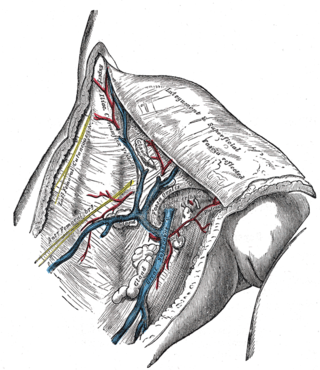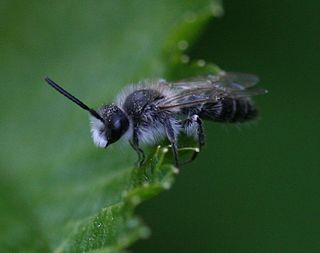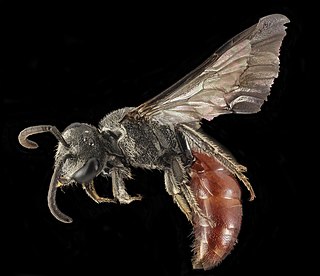
The great saphenous vein (GSV) or long saphenous vein is a large, subcutaneous, superficial vein of the leg. It is the longest vein in the body, running along the length of the lower limb, returning blood from the foot, leg and thigh to the deep femoral vein at the femoral triangle.

Halictidae is the second-largest family of bees with nearly 4,500 species. They are commonly called sweat bees, as they are often attracted to perspiration. Halictid species are an extremely diverse group that can vary greatly in appearance. These bees occur all over the world and are found on every continent except Antarctica. Usually dark-colored and often metallic, halictids are found in various sizes, colors and patterns. Several species are all or partly green and a few are red, purple, or blue. A number of them have yellow markings, especially the males, which commonly have yellow faces, a pattern widespread among the various families of bees. The family is one of many with short tongues and is best distinguished by the arcuate basal vein found on the wing. Females in this family tend to be larger than the males. They are the group for which the term 'eusocial' was first coined by entomologist, Suzanne Batra.

In human anatomy, the groin, also known as the inguinal region or iliac region, is the junctional area between the torso and the thigh. The groin is at the front of the body on either side of the pubic tubercle, where the lower part of the abdominal wall meets the thigh. A fold or crease is formed at this junction known as the inguinal groove, or crease. This is also the area of the medial compartment of the thigh that contains attachments of the adductor muscles of the hip or the groin muscles. The groin is the common site for a hernia.
Heinrich Friedrich August Karl Ludwig Friese was a German biologist and entomologist, a specialist of bees (melittologist). Between 1883 and 1939, he described 1,989 new species and 564 new varieties or subspecies of insects, 99% of which were bees.
Sphecodes crassicornis is a species of bee in the genus Sphecodes, of the family Halictidae.
Sphecodes decorus is a species of bee in the genus Sphecodes, of the family Halictidae. S. decorus has been documented in India and Sri Lanka.
Sphecodes schenckii is a solitary cleptoparasitic bee which is found in southern and eastern Europe and the Middle East. Its host is Lasioglossum discum and possibly Halictus simplex where L. discum does not occur such as in southern Germany and Switzerland. It is rare and there are only a few records from each country from which it has been recorded. It prefers warm open areas, such as grasslands and Mediterranean scrub, and may be threatened by reafforestation and vegetation succession. The specific name schenckii is in honour of the German Hymenopterist Adolph Schenck.

Sphecodes is a genus of cuckoo bees from the family Halictidae, the majority of which are black and red in colour and are colloquially known as blood bees. Sphecodes bees are kleptoparasitic on other bees, especially bees in the genera Lasioglossum, Halictus and Andrena. The adults consume nectar, but because they use other bees' provisions to feed their offspring they do not collect pollen.

Sphecodes gibbus, the dark-winged blood bee, is a species of cleptoparasitic blood bee from the Palearctic. It is the type species of the genus Sphecodes and was first described by Carl Linnaeus as Sphex gibba in 1758.
Sphecodes mandibularis is a species of sweat bee in the family Halictidae.

Andrena barbilabris, the bearded miner bee, is a species of miner bee in the family Andrenidae. It is found in Europe and Northern Asia and North America.

Sphecodes ranunculi is a species of sweat bee in the family Halictidae.
Sphecodes confertus is a species of sweat bee in the family Halictidae.
Sphecodes heraclei is a species of sweat bee in the family Halictidae.

Sphecodes aroniae is a species of sweat bee in the family Halictidae.
Sphecodes solonis is a species of sweat bee in the family Halictidae.
Sphecodes johnsonii is a species of sweat bee in the family Halictidae.








